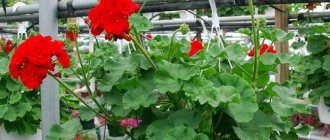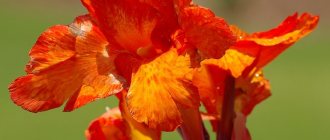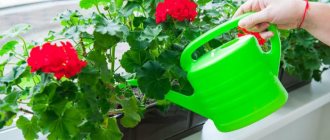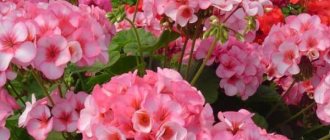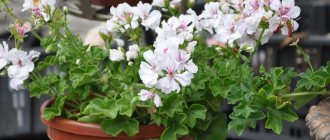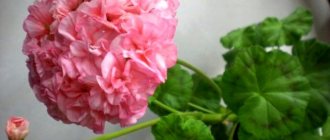Closer to winter, like many plants, geranium requires special care, the provision of which must be competent, because only in this case will it be able to delight the eye with its abundant flowering in spring and summer.
How to organize proper care for geraniums in winter and spring? How to prune before wintering and preserve the plant at home? You will find detailed information in the article below.
Preparing for winter: pruning
Preparation for the dormant period begins in the fall, and the most important thing to do is to prune the geranium.
This will subsequently have a huge impact on how it will bloom. Without pruning, even if all the necessary conditions outlined below are met, such lush and beautiful flowers will not appear on the plant. Procedure for pruning geraniums:
- At the end of September, absolutely all flower stalks are cut off, regardless of whether they have faded or are still actively doing so. This is done to help geraniums preserve their reserves of resources for the winter.
- All leaves that have already turned yellow and withered or have just begun to do so are plucked off or cut off. Experienced gardeners recommend pinching them off rather than cutting them with scissors. In the second case, mere protruding roots remain.
- For dense flowering in September, geranium is pruned so that the beginning of the branches remains, or just above (3–5 cm) the node. The upper cut part can be rooted as a cutting.
You need to prune the plant until it loses its beautiful and lush appearance. If the plant is young, then it is only pinched , and this is done according to the following rules:
- Pinching of young plants begins when their height reaches 5–6 cm.
- After the geranium grows another 5 cm, pinching is done again.
- To achieve a spherical shape, you can pinch it 3 times in a similar pattern.
In this case, pruning can be done both in autumn and in spring, it depends on the variety of geranium. For example, zonal geraniums tend to grow, and if this does not bother you at all, then you don’t have to prune them, but it’s better not to touch very small plants until spring.
For variegated varieties, pruning is very stressful, so it is better to prune them in the spring. You only need to trim the hanging ones when they grow too much.
For small geraniums, pruning will not play a big role, but for those that are large, it is very important.
Winter storage conditions
Autumn is a crucial period for gardeners when it is necessary to prepare their favorite plants for winter. How I want to save all the flowers so that next season they will again delight the eye with an abundance of colors. Many housewives use geraniums not only as a houseplant, but also decorate flower beds with them and plant them in pots outdoors in the spring. With the onset of cold weather, you need to decide how to preserve geraniums during this period.
From December to February, pelargonium enters a dormant phase, so its growth and flowering slow down. It is for this reason that there is no need to feed the plant during this period. She needs to be allowed to get stronger and gain strength before the new growing season. Until about January, pelargonium will delight its owners with bright, beautiful flowers. Its growing season begins from mid-spring until autumn.
There are several ways to preserve geraniums in winter: in the basement and in the apartment. The plant can be used as an indoor plant. One of the most common methods is to take cuttings, root them, and plant them outdoors again in the spring.
Wintering rules
If you want to help geraniums overwinter, you need to make a preliminary selection of plants intended for wintering. Severely sick plants or too weak ones are not suitable for wintering. Strong and healthy plants overwinter better, because then you have the greatest chance that the pelargonium will bloom again in a year, and its cuttings will be raised equally healthy and strong.
Pelargonium cannot be stored for longer than two years. Old plants should be thrown away as they lose their decorative value.
Plants bloom best in the first year after rooting. To overwinter geraniums, you need to choose healthy plants that bloomed profusely and grew lushly.
How to prune geraniums for the winter
Before the onset of winter, you need to remove geranium shoots with a disinfected tool. This is a sharp knife (kitchen or stationery) or blade.
Scissors are not suitable for this procedure, as they pinch the stem.
- The trunk of the geranium is cut three to five millimeters above the leaf node.
- The cut is made at an acute angle.
- You should choose nodules directed towards the outside of the bush.
When shoots grow from such a bud, the shoots will not lead to thickening of the crown, as they will tend to separate from the center of the bush.
How to preserve a plant at home and can it be stored in the basement?
Already in the fall, the pot with the plant is placed in a cool and dimly lit place. A southern or northern window sill in a house/apartment is quite suitable for this, since there is diffused sunlight there. And to make up for the lack of light at this time, you can use fluorescent lamps. The optimal daylight hours are 12 hours.
Such lamps are an excellent solution if it is not possible to place geraniums on the windowsill: you can independently build racks with lamps, thanks to which they can be placed anywhere in the house/apartment. Also, additional lighting guarantees the uniform development of all shoots (when there is insufficient lighting, they begin to stretch).
The frequency of watering and the amount of water for this are gradually reduced, because the plant stores water in its thick stems for the winter. You need to water so that the soil is very slightly moist, and the next watering should be done when the substrate is completely dry.
highly not recommended to fertilize geraniums until the very beginning of March. If the plant suddenly begins to wither, you can add fertilizer, but not more than once every month and a half.
It is better to reduce the temperature to 10 - 12 degrees, so for the winter it is convenient to place the flower on the balcony or in the basement. This temperature regime is observed until the beginning of spring.
Despite the fact that in the cold season geranium should be in a room where the temperature is extremely low, it does not tolerate cold drafts. Therefore, during any ventilation, the plant should be removed as far as possible from the open window.
How to prepare geraniums for winter in an apartment
Glazed loggia or insulated balcony
Most pelargoniums overwinter on a glassed-in loggia, where the air temperature on frosty winter nights does not drop below +12°C. In such almost ideal conditions, some plants continue to bloom (not as luxuriantly as in summer) for most of the winter. Some pots with bushes are placed in hanging baskets and flowerpots, others are placed on tables and a ladder-stand for plants. This option allows you to get by with corrective pruning in the fall and more radical pruning in late February - early March.
Watering is moderate. No feeding. With this content, pelargoniums bloom for a long time, and by spring they themselves go into “standby mode”. The buds hardly open, allowing the plant to rest and gain strength. Some of the leaves dry out periodically.
Windowsill
There are no problems with growing pelargoniums on the windowsill. The main thing is to find a place for them. Pots or boxes are placed on foam sheets or packaging trays so as not to chill the root system. Open windows and transoms pose a danger on frosty days. It’s bad if there’s a battery nearby. Autumn pruning when grown on a windowsill is gentle, since pelargoniums do not go into hibernation and continue to bloom. But strong spring pruning is necessary. Care comes down to fairly infrequent watering, cleaning of dried leaves and flower stalks and pest control.
Frost-proof garage and staircase
Many of my acquaintances, amateur flower growers, store flowerpots, boxes and large pots of pelargoniums in frost-free garages and stairwells in winter. Before this, the plants are heavily pruned, leaving parts 15-20 cm high. Large branches are shortened, but not removed. Water several times during the winter, very moderately, just so that the soil and roots do not dry out.
Fridge
When storing pelargoniums in the refrigerator (on the top shelf, shelves on the door, in vegetable drawers), you first need to work with the bushes. In dry weather at the end of September or October (depending on the weather and life circumstances), pelargoniums are removed from the ground along with the root system. After this, most of the roots are carefully cut off, leaving a ball of roots with soil (about 8 - 10 cm).
This lump does not need to be moistened; it is better if it is dry enough. It is wrapped in film so that the soil does not spill out. Pelargonium is trimmed, leaving a stump from the ground part of such a size that two plants can fit in a liter bag of juice or milk. The package is wrapped in newspaper folded into several parts. From time to time the condition of stored pelargoniums is checked. Check to see if the paper is wet. In February, pelargoniums are taken out, planted in containers and germination begins.
"Upside down"
There are many other options for preserving pelargoniums brought from the site to the house. Among them, attention is drawn to hanging the bush upside down, when a lump of shortened roots with soil or peat is packed in a plastic bag, tied tightly and hung from a hook or shelf in a cool place (for example, in a basement). The ground part is also greatly shortened. Experts consider this unusual option for wintering pelargoniums to be very effective and guarantee lush flowering next year.
Old gardeners say that it would be good to sprinkle the roots with sulfur powder, which will prevent the roots from rotting.
At the end of winter, the geranium is moved from the basement, pulled out of the paper and the rotten roots are cut off. After which, they are planted in fresh, damp soil. It is necessary to water only when the first leaves appear on the stems.
Spring care
At the beginning of March, geranium begins to gradually wake up in order to intensively spend its energy accumulated over its entire dormant period. To do this, the temperature in the room where the flower is located gradually increases. If it was on the balcony, then you can simply bring it into the apartment, and the room temperature will be quite suitable for the entire growing season.
In spring, the rule for this plant is: “the more light, the better!” Therefore, a pot of geraniums is placed on the most illuminated windowsill in the apartment, and it does not matter at all whether diffused or direct sunlight gets there. Only on those days when the sun is especially scorching can the plant be covered with something.
Wintering large-flowered pelargoniums
Large-flowered geraniums do not have to go through a pronounced dormant period like zonal pelargoniums and can be stored at higher temperatures. In order for them to bloom again in the spring, they must be stored in a well-lit room with a temperature of 12-14°C, but no more! In such conditions they will grow all the time. It takes them 2 months to create new flower buds.
When you notice the first buds you need to raise the temperature to 18°C. Thanks to these winter conditions, geranium will bloom in April. If for some reason you cannot provide the plant with the above conditions, you need to overwinter the geranium in the same way as the previous zonal pelargonium. Then the plant will remain dormant. This will not harm them, they will just bloom a little later.
Will this geranium overwinter outdoors?
Some types of geraniums are native Russian plants and decorate our forests and meadows. Which, by the way, often and completely unfairly turns people away from this culture. The following species overwinter in the open ground without problems: magnificent geranium, Himalayan geranium, Dalmatian geranium (G. dalmaticum), red-brown, blood-red (G. sanguineum), macrorhizum (G. macrorhizum), Cantabrigen geranium (G. x cantabrigiense), Clarke (G. сlarkei), forest (G. sylvaticum), meadow, small-stamen (G. psilostemon), oxon (G. x oxonianum), spotted (G. maculatum), ash, Renard (G. renardii), Farrera (G. farreri), erianthum (G. erianthum). Some hybrid varieties, for example “Blue Blood”, “Patricia”, “Salome”, “Ann Folkard”, “Sue Crug”, winter well under snow cover, but there is some risk when growing them, since there are frosts on bare ground in autumn . And under cover there is a danger of damping off. However, flower growers have been successfully growing these varieties for several years now.
For color ideas - dark-leaved varieties
Meadow geranium has several varieties with dark burgundy almost black foliage. It started with the variety "Victor Reiter", but it does not have the darkest foliage. Varieties of the same meadow geranium, different in height, are very decorative: “Midnigth Reiter”, “O’key Dokey”, “Hocus Pocus”, “Black Beauty”, “Purple Heron”. The blue-blue rather large flowers look harmonious with their carved leaves. Varieties with brown foliage of spotted geranium have appeared - “Espresso” and “Elizabeth Ann”. Red-brown geranium pleases with purple-brown spots on a dark green background of carved leaves. The Samobor variety is especially good. Here the foliage dominates, the flowers are much more modest.
Plant in sun or shade
In an open sunny place, Dalmatian, East Tibetan (G. orientalitibeticum, despite its origin, has been wintering in the middle zone for several years), Ash, Farrera, Renarda geraniums feel good. These are all low geraniums. Conversely, magnificent, forest, red-brown, blood-red, marsh (G. palustre), large-rhizomatous, and small-stamen varieties grow well in partial shade and even in the shade.
Marsh, red-brown and Endres geraniums tolerate excess moisture well. Himalayan, Dalmatian, large-rhizome, ash, and Cantobrigen geraniums tolerate dry soil.
But it is better not to experiment, but to provide normal watering to the plants.
Description of the plant
Pelargonium is a genus of plants in the Geranium family. It grows naturally in South Africa. This genus includes about 250 species. The smell of pelargonium is very specific; it cannot be confused with anything else. Essential oils contained in the leaves of the plant create a natural barrier to bacteria and viruses .
ATTENTION : Many people believe that pelargonium and geranium are the same thing, but this is not so. Geranium, or cranebird, is also a representative of the genus of the Geranium family.
Geranium, growing in the wild. In Russia, it is not customary for flower growers to distinguish between these types of plants, considering the words “geranium” and “pelargonium” to be synonymous. Geranium is used in folk medicine: for insomnia, depression, rheumatism, heart disease .
If home flowers are attacked by aphids, it is advised to place a pot of pelargonium next to them, which expels pests.
You need a lot of geraniums, you will have to propagate them
All methods of propagating geraniums are good. Most often, the bush is divided in the spring. In geraniums that are difficult to disassemble into segments (this is especially true for the varieties “Ann Folkard”, “Patricia”, “Rosanna”, as well as varieties of ash geranium), you can separate a young shoot without roots, as they say, with a heel and, removing it from Most of the leaves can be planted in a greenhouse, or just under a jar. After 2-4 weeks, the plant will take root and be ready to be transplanted to a permanent location.
You can cut root cuttings of geraniums in the spring, treat them with Kornevin and place them in a greenhouse until leaves form. This is the best way to propagate blood-red geranium.
- Author: Maria Sukhorukikh
Rate this article:
- 5
- 4
- 3
- 2
- 1
(0 votes, average: 0 out of 5)
Share with your friends!
Periods of growth and rest
From December to February, pelargonium enters a dormant phase, so its growth and flowering slow down. It is for this reason that there is no need to feed the plant during this period. She needs to be allowed to get stronger and gain strength before the new growing season (read about how to feed geraniums for lush flowering here, and from this article you will learn how to properly use iodine with hydrogen peroxide to feed a flower). Until about January, pelargonium will delight its owners with bright, beautiful flowers. Its growing season begins from mid-spring until autumn .
